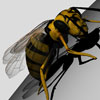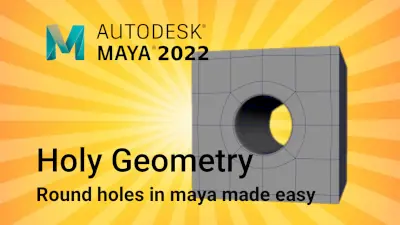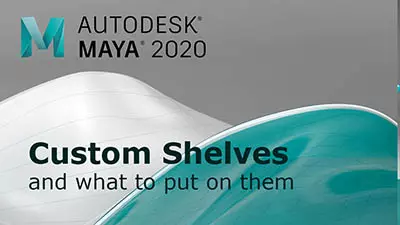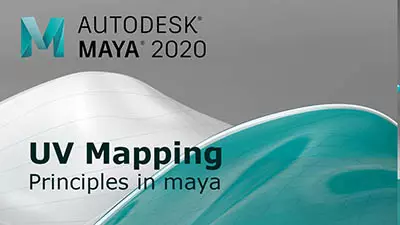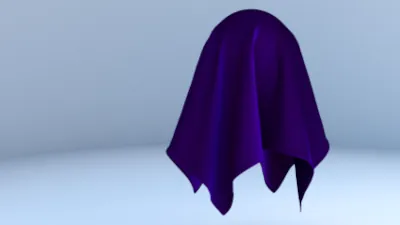Beer glass scene creation
This course contains a little bit of everything with modeling, UVing, texturing and dynamics in Maya, as well as compositing multilayered EXR's in Photoshop.
#
1
25-05-2004
, 11:38 AM
Subscriber
Join Date: Mar 2003
Join Date: Mar 2003
Location: Manchester UK
Posts: 159
How to raise surface 'slightly'
I am trying to learn some basic NURBS modelling techniques by just modelling different objects and trying various ways of making the shape.
At the moment I am attempting to make a "Desk Fan" and am stuck on how to make the "Control Panel' sit slightly proud of the rest of the surface.
Methods tried - I did try to 'offset' the highlighted Isoparm (raised and scaled in very slightly) then Lofted to this curve - But I get very unpredictable results.
The other way I tried was to "Duplicate the surface patches"
then lift them, but then I had problems as I could not seem to Fillet or loft to the edges as everytime I selected the 'duplicated patches' - It would only select 1 patch? (I tried shift/clicking but couldn't get it to work)
Basically my question is, how should I be creating these 'very slightly' raised surfaces.
If you cannot tell from my picture what i'm trying to do, then picture the controls on an IPOD and see how they are slightly proud? that's what I am trying to do.
Regards Scraggy
#
2
25-05-2004
, 06:08 PM
Why don't you just pick a few CVs and move them up? Or you can create the panel as an entirerly different surface and just have it sit ontop of that surface intersecting (so you can't see holes) but not actually conected.
There can not be Good without Evil, so then it must be good to be Evil sometimes.
:tup:
#
3
25-05-2004
, 09:09 PM
#
4
25-05-2004
, 10:38 PM
Subscriber
Join Date: Mar 2003
Join Date: Mar 2003
Location: Manchester UK
Posts: 159
Hope this is a bit better...
Thanks, I realised I did not shift selected the 'top' isoparm in the last Pic i sent, so no wonder it was confusing to you...
Sorry about that, I have a picture here but unfortunately it is very blurred due to the "Auto Guess" Focus on my Digi camera.
I hope you can see what i'm trying to do (I wasn't being quite so bold and was content with 1 raised surface, as you can just about - see there are 2 'ridges' on the Fan)
Plus I had no idea how to get the sides flat like that so used 'artistic liscence' If you have any ideas how I should have done it, I would be grateful.
Ow yeah and the Fan blades are next - I was thinking that 'Birail' or just twisting a Nurbs loft would do... But that's theory

Regards Scraggy_d
Last edited by Scraggy_dog; 25-05-2004 at 10:41 PM.
#
5
25-05-2004
, 10:43 PM
Subscriber
Join Date: Mar 2003
Join Date: Mar 2003
Location: Manchester UK
Posts: 159
Picture
As you can see now - it's more of an abrupt change than I can get from just manipulating vertices (I think?)
#
6
26-05-2004
, 06:58 AM
Additionaly, I think I can see a little edge around that panel, I could be wrong, I can't really tell by the picture. Well, in that case then just repeat the same thing by first duplication the original curve twice and making them one smalled than the other.
There can not be Good without Evil, so then it must be good to be Evil sometimes.
:tup:
#
7
26-05-2004
, 11:05 PM
Subscriber
Join Date: Mar 2003
Join Date: Mar 2003
Location: Manchester UK
Posts: 159
Hi..
Thanks a lot for your explanation, one thing I realised that I had not even tried yet was "Offset Surfaces" ...
I am really glad you showed me that as I'm sure as soon as I get the 'hang' of this... I have 1 problem though -
I have tried to follow along with your explanation, but sadly I seem to get stuck at the part where I connect the two halves together.
I have also realised that an edge of a Nurbs is not necessarrily an Isoparm (Because I cannot select it to 'Fillet' to.) - So I did "Surface point"/"drag"/"Create Isoparm" -But it is all skewed wrongly.....[See on last photo]
I may just start again knowing more now.
I'm thinking, if my Isoparm isn't as mis-aligned, then maybe the fillet will work?
Regards Scraggy
#
8
27-05-2004
, 12:15 AM
There can not be Good without Evil, so then it must be good to be Evil sometimes.
:tup:
#
9
27-05-2004
, 12:33 AM
#
10
27-05-2004
, 01:33 AM
 I was in the middle of taking screenshots of the intructions when something got messed up in one of the surfaces and I can't find a way to fix is (it's a bug). Some how the normals of the surface apear outside the surface, I thought it was a problem with my video card, but it stays there no matter what I do (not even undo worked). Ans since I'm too lazy to do it al over again, I'll just "type" the detailed instructions intead. Sorry.
I was in the middle of taking screenshots of the intructions when something got messed up in one of the surfaces and I can't find a way to fix is (it's a bug). Some how the normals of the surface apear outside the surface, I thought it was a problem with my video card, but it stays there no matter what I do (not even undo worked). Ans since I'm too lazy to do it al over again, I'll just "type" the detailed instructions intead. Sorry. 
Well, here we go.
1.- create you surface, I will refer to this as "surface 1", but you can call it whatever you want.
2.- select surface one and then click "Edit NURBS>Offset Surfaces".
3.- open the attribute edito and it should be displaying the option for the offset that you just did. I will refer to the new surface as "surface 2".
4.- in the attribute editor, under "Offset Surface History" change the "distance" value as you see fit. For me it worked fine with 0.3. The number will be negative or positive depending on where the surface normals are pointing at.
5.- before you continue make sure both surfaces are closed, specially because surface 2 might have a gap somewhere because of the way the surface is offset.
6.- go to the top view and draw a closed curve where you want the surface to be raised.
7.- while still in the top view, select that curve and both surface 1 and surface 2 and then click "Edit NURBS>Project Curve on Surface".
8.- select surface 2 and then click "Edit NURBS>Trim Tool".
9.- the surface will aprea as a white grid now, where the curve that you projected to it will be thicker than the rest, and the area above the curve will have a different looking grid than the area below the curve (this lets you know that the curve is actually separating the surface in two parts).
10.- the way the trim tool works is, you mark with a yellow cube the part of the surface that you want to keep and you do nothing to the part that you want to get rid of. So click somewhere in the top part of the surface (by the way, we are working in persp view now).
11.- hit enter. Now part of the surface should be gone. Make sure you kept the part that you wanted to keep before you continue. If you got the wrong one just click "Edit NURBS>Untrim Surfaces".
12.- repeat steps 8, 9, 10, and 11, except that this time select surface 1, and leave the yellow square on the oposite part of the surface.
13.- now you should have something that looks like the image that I did posted in this post (look bellow this text); except for that yellow edge, I'll explain the yellow in a moment.
14.- if you have trimed the surfaces where they should be trimed and nos have two halves of the surface offset from one another, then it's time to select the trim edge.
15.- hold down the right mouse button over surface 1 until a little menu pops up. From the menu chose "Trim Edge". Now carefully click where the yellow line that I mentioned in step 13 is. So not yours should look like the picture.
16.- repeat step 15 with surface 2, but before you click the edge remmember to hold down "Shift" so that you don't lose the previous selection.
17.- if you have the 2 yellow lines, click "Edit NURBS>Surface Fillet>Freeform Fillet".
18.- with some luck, that did it, and it's the end of it, congratulations. However, you might get a weird twisted surface 3. If that happens then undo the last step (or delete surface 3) and try to change the direcion of the surfaces and try the freeform fillet again. This might take some ingenuity. For example, while attaching the sleves in my parrot pirate for this month's challenge I got the twisted fillet, it after poking arround a bit I realized that the surface for the sleve (which started as a cylinder) had it's begining CV pointing north, while the curve that I projected to the chest had it's first CV pointing south. I solved the problem by simply rotating the curve to match up the sleeve. Deleting history also helps some times.
Good luck with that. And sorry I couldn't get the screen shots like I said I would

There can not be Good without Evil, so then it must be good to be Evil sometimes.
:tup:
#
11
27-05-2004
, 02:40 AM
#
12
27-05-2004
, 05:47 PM
Subscriber
Join Date: Mar 2003
Join Date: Mar 2003
Location: Manchester UK
Posts: 159
Many thanks.......
(a) How to use the "Offset surface" tool (Although I could not find the attribute for distance in the editor [I'm on Maya 4.5] but that's no matter while I have Undo
(b) How to select curves using "Trim edge" (I had never even noticed that one before!)
I must admit when I started the trim and realised that I needed to select "TWO" surfaces to keep, I fluttered a bit until I realised that you can shift-select a second surface to keep.

I have followed your little 'tutorial' on a copied fan so I could play with the settings e.t.c. and am happy to say it came out like this..... (See below) on the first try...
Ok next - (So I can learn more NURBS) I am going to try to make a "Fan Propellor" next.
- I think I will try to use Birail tools to create it as they look very powerful tools to know, and at the time of writing, I haven't a clue as to how to use them.
Thanks again guys Scraggy
#
13
27-05-2004
, 06:38 PM
There can not be Good without Evil, so then it must be good to be Evil sometimes.
:tup:
#
14
27-05-2004
, 06:43 PM
There can not be Good without Evil, so then it must be good to be Evil sometimes.
:tup:
#
15
27-05-2004
, 09:18 PM
Subscriber
Join Date: Mar 2003
Join Date: Mar 2003
Location: Manchester UK
Posts: 159
Thanks for that,

At first you mention Surface fillets, then at the end it says to do a "freeform fillet" - I am wondering now what the differences are.?
[Maybe not easy to explain?]
I Tried to do what you said about the base but got rather confused in the process. (Pic enclosed)
I am a slow learner it seems, (Can't teach an old dogg new tricks?) but I will go onto the Alias site and look up all the fillets and especially "Duplicate surface Curve" on 3D-101 ....
- I will have a mess around with it - then if I still cannot get the "hang" of it - I will come and Bug y'all again

Regards Scraggy

Posting Rules Forum Rules
Similar Threads
Help - Mental Ray error on Sub D crease
by davidorff07 in forum Lighting & Rendering replies 0 on 13-04-2007
Particles moving on a surface! Please Help!
by Eurofiles in forum Dynamics & Special Effects replies 4 on 31-07-2006
Particles moving on a surface! Please Help!
by Eurofiles in forum Work In Progress replies 1 on 28-07-2006
I have a problem with Attach, Rebuild, Detach surface.
by ming in forum Maya Basics & Newbie Lounge replies 0 on 19-05-2006
fur rendering failed?????
by olivermagno in forum Maya Materials & Textures replies 2 on 21-05-2003
Topics
Free Courses
Full Courses
VFX News
How computer animation was used 30 years ago to make a Roger Rabbit short
On 2022-07-18 14:30:13
Sneak peek at Houdini 19.5
On 2022-07-18 14:17:59
VFX Breakdown The Man Who Fell To Earth
On 2022-07-15 13:14:36
Resident Evil - Teaser Trailer
On 2022-05-13 13:52:25
New cloud modeling nodes for Bifrost
On 2022-05-02 20:24:13
MPC Showreel 2022
On 2022-04-13 16:02:13


